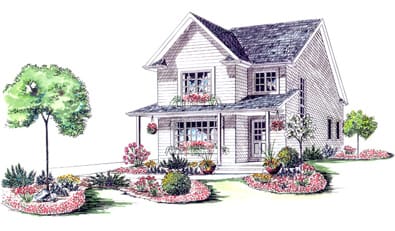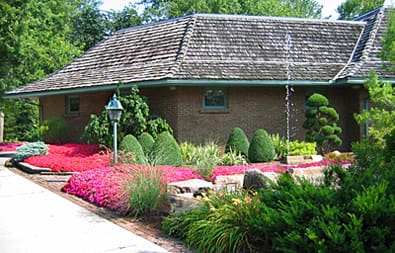Garden design 3 – white house
Garden landscape idea for a white house
This full sun garden can have more or less plants depending on the look that you want.

Flowers included in this garden
Geraniums (red), ivy geraniums (red), impatiens (burgundy red), begonia (red), petunia (wave), dusty miller, vinca vine, dracaena spike, sprengerii, marigold (gold), pansy, kale.
Trees and shrubs included in this garden
Garden Juniper, Anthony Waterer Spirea, PeeGee Hydrangia, Viburnum, Weeping Caragana, Dwarf Hugo Pine.
Learn more about growing trees.
Know your soil
When it comes to planting, good soil is the foundation on which you build a good garden. And building good soil involves analyzing what you’ve got and supplementing what it needs.
Along with organic matter or humus there are three primary minerals that make up soil: sand, clay, and silt. The right balance of both humus and minerals will achieve garden loam, the best soil for growing plants. For more information visit our soil tips.
Planting and spacing
Click on the flower name in the list above and you will find all the planting and care instructions for each individual flower. Or visit our extensive annuals section.
Spacing is a personal preference. Planting flowers closer together will give a fuller coverage in your garden and vice versa. As a general guideline you can start with the following:
1. Multiply the length by the width of your garden or planting area to get your square footage.
2. Multiply the square footage by 4. This is the number of plants you will need for full coverage in your garden.
Example: 4 foot length x 3 foot width = 12 square feet
12 square feet x 4 = 48 plants

Planning your garden
For beginners it is important to draw a plan:
- Choose plants suitable for the site (light, soil, etc.)
- Arrange plants according to their height (i.e. taller flowers at back, shorter ones at front)
- Arrange according to plant form and texture
- Arrange according to flowering periods for constant blooms
- Arrange in groupings by type and color considerations
